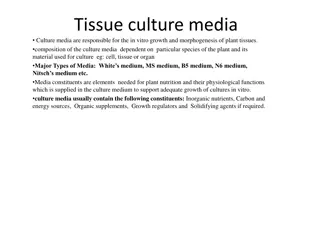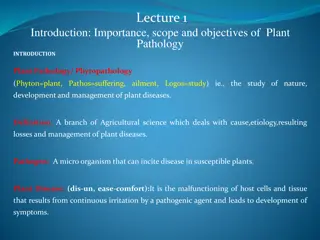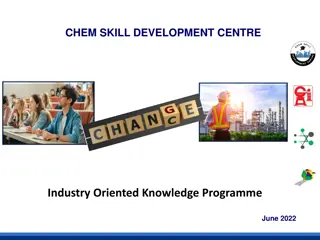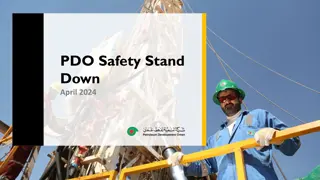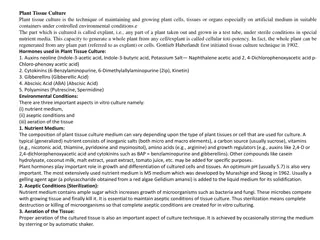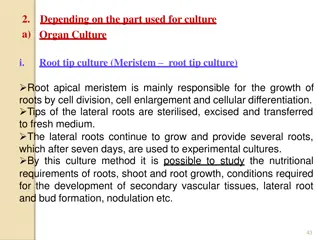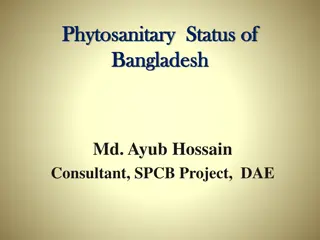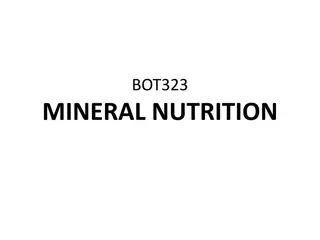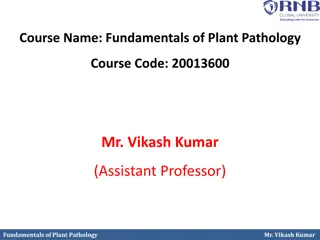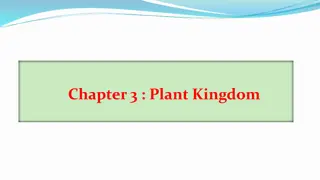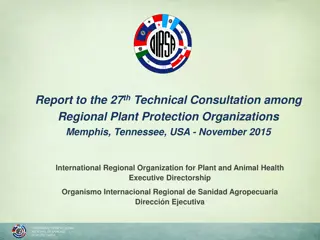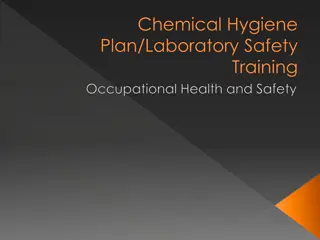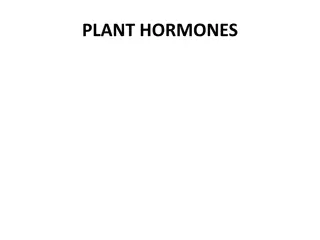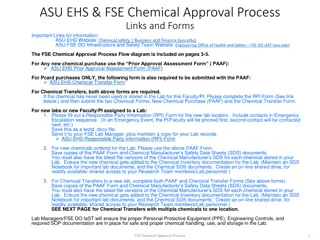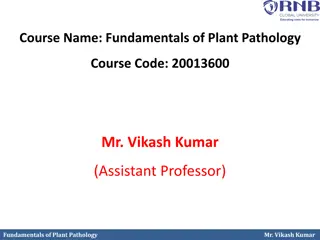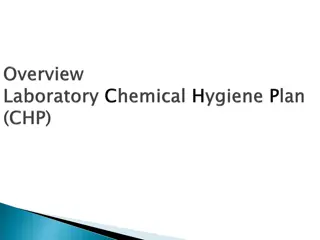
Insights into Chemical Plant Safety
Robert M. Solow, a Nobel laureate economist, emphasized the role of technological advancements in economic growth. Chemical engineers play a crucial role in ensuring safety in complex processes, utilizing tools like dispersion models and mathematical techniques. Chemical plant safety involves accident prevention, hazard identification, and loss prevention strategies. Key terms like hazard, risk, and safety programs are vital in understanding and managing safety in chemical processes.
Download Presentation

Please find below an Image/Link to download the presentation.
The content on the website is provided AS IS for your information and personal use only. It may not be sold, licensed, or shared on other websites without obtaining consent from the author. If you encounter any issues during the download, it is possible that the publisher has removed the file from their server.
You are allowed to download the files provided on this website for personal or commercial use, subject to the condition that they are used lawfully. All files are the property of their respective owners.
The content on the website is provided AS IS for your information and personal use only. It may not be sold, licensed, or shared on other websites without obtaining consent from the author.
E N D
Presentation Transcript
In 1987, Robert M. Solow, an economist at the Massachusetts Institute of Technology, Nobel Prize in economics for his work in determining the sources of economic growth Economy s growth is the result of technological advances more complex processes: higher pressure, more reactive chemicals, and exotic chemistry more complex safety technology
As chemical engineers will need a more detailed and fundamental understanding of safety. safety is equal in importance to production and has developed into a scientific discipline highly technical and complex theories and practices. Examples of the technology of safety include Hydrodynamic models representing two-phase flow Dispersion models representing the spread of toxic vapor Mathematical techniques to determine the various ways that processes can fail and the probability of failure
Chemical plant safety emphasize: use of appropriate technological tools to provide information for making safety decisions with respect to plant design and operation. safety: Accident prevention (older strategy) worker safety through the use of hard hats, safety shoes, and a variety of rules and regulations technical evaluation, and the design of new engineering features to prevent loss. Loss prevention includes hazard identification,
Frequently used terms in chemical process safety Safety the hazards of a chemical plant and eliminate them before an accident occurs Hazard potential to cause damage to people, property, or the environment. Risk: damage, or economic loss (incident likelihood, magnitude of the loss ) Safety or or loss preve loss prevention ntion: Technologies to identify Hazard: a chemical or physical condition that has the Risk: measure of human injury, environmental
Large variety of hazard Mechanical hazards: Worker injuries from tripping, falling, or moving equipment Chemical hazards: Fire and explosion hazards, reactivity hazards, and toxic hazards Safety Programs: (Forparticipants) A successful safety program ingredients are System Attitude Fundamentals Experience Time You
System (1) to record what needs to be done (2) to do what needs to be done (3) to record that the required tasks are done Attitude: Participants must have a positive attitude. willingness to do some of the thankless work that is required for success. Fundamentals: Must understand and use the fundamentals of chemical process safety.
Experience: Learn from the experience of history (1) read and understand case histories of past accidents and (2) ask people in their own and other organizations for their experience and advice Time: Safety takes time. This includes time to study time to do the work time to record results (for history) time to share experiences time to train or be trained. You:everyone (you) should take the responsibility to contribute to the safety program.
Distinction between a good and an outstanding safety program. Good safety program: identifies and eliminates existing safety hazards. Outstanding safety program: has management systems that prevent the existence of safety hazards. prevents the existence of a hazard in the first place include Safety reviews, Safety audits, Hazard identification techniques, Checklists, Proper application of technical knowledge
Engineers are responsible for minimizing losses and providing a safe and secure environment for the company s employees Responsibility to themselves, fellow workers Family, community, and the engineering profession. Part of this responsibility is described by the American Institute of ChemicalEngineers
American Institute of Chemical Engineers Code of Professional Ethics
END of The Lecture Thanks Thanks
Accident and loss statistics are important measures of the effectiveness of safety programs process is safe or safety procedure is working effectively No single method is capable of measuring all required aspects Many statistical methods are available Three systems considered here are OSHA incidence rate, Fatal accident rate (FAR) Fatality rate, or deaths per person per year All three methods report the number of accidents and/or fatalities for a fixed number of workers during a specified period.
Occupational Safety and Health Administration of the United States government. OSHA is responsible for ensuring that workers are provided with a safe working environment OSHA definitions applicable to accident statistics references Injury Facts, 1999 ed. (Chicago: National Safety Council, 1999), p. 151. OSHA regulations, 29 CFR 1904.12.
Accident and Loss Statistics Accident and Loss Statistics
Based on cases per 100 worker/years. A worker 2000 hours (50 work weeks/year 40 hours/week) The OSHA incidence rate is therefore based on 20,0000 hours of worker exposure to a hazard. Provides information on all types of work-related injuries and illnesses, including fatalities Better representation of worker accidents than systems based on fatalities alone For instance, a plant might experience many small accidents with resulting injuries but no fatalities
OSHA incidence rate: Number of occupational injuries and illnesses and the total number of employee hours worked during the applicable period An incidence rate can also be based on lost workdays instead of injuries and illnesses
Mostly used by the British chemical industry Reports the number of fatalities based on 1000 employees working their entire lifetime Employees are assumed to work a total of 50 years Based on 108 working hours
or deaths per person per year Independent of the number of hours actually worked Report only the number of fatalities expected per person per year Useful for performing calculations on the general population where number of exposed hours is poorly defined
Both the OSHA incidence rate and the FAR depend on the number of exposed hours An employee working a ten-hour shift is at greater total risk than one working an eight-hour shift FAR can be converted to a fatality rate (or vice versa) if the number of exposed hours is known OSHA incidence rate cannot be readily converted to a FAR or fatality rate
A process has a reported FAR of 2. If an employee works a standard 8-hr shift 300 days per year, compute the deaths per person per year. Solution Solution Deaths per person per year = (8 hr/day) x (300 days/yr) x (2 = 4.8 x 10-5. deaths/108 hr)
Example 1 If twice as many people used motorcycles for the same average amount of time each, what will happen to (a) the OSHA incidence rate, (b) the FAR, (c) the fatality rate, and (d) the total number of fatalities? Solution a. The OSHA incidence rate will remain the same. The number of injuries and deaths will double, but the total number of hours exposed will double as well. b. The FAR will remain unchanged for the same reason as in part a. c. The fatality rate, or deaths per person per year, will double. The fatality rate does not depend on exposed hours. d. The total number of fatalities will double. Example 1- -2. 2.
Accident statistics do not include information on the total number of deaths from a single incident Example consider two separate chemical plants. Both plants have a probability of explosion and complete devastation once every 1000 years. The first plant employs a single operator. When the plant explodes, the operator is the sole fatality. The second plant employs 10 operators. In both cases the FAR and OSHA incidence rate are the same. correspondingly larger number of exposed hours.
Property damage and loss of production must also be considered in loss prevention. These losses can be substantial. Accidents of this type are much more common than fatalities. No Damage accidents are called near misses provide a good opportunity for determine that a problem exists
Each company needs to determine an appropriate level for safety expenditures. This is part of risk management Engineers need to also consider other alternatives when designing safety improvements otherwise may make the system unduly complex It is also important to recognize the causes of accidental deaths, Most company safety programs are directed toward preventing injuries to employees, the programs should include off-the-job safety Although the emphasis of chemical-related accidents include training to prevent injuries resulting from transportation, assaults, mechanical and chemical exposures, and fires and explosions.
Every chemical process has a certain amount of risk associated with it Engineers must make every effort to minimize risks within the economic constraints of the process. No engineer should ever design a process that he or she knows will result in certain human loss or injury Public Perceptions Acceptable risk are assuming that these risks are satisfactory to the civilians living near the plant The results of a public opinion survey on the hazards of chemicals
The results show an almost even three- way split, with a small margin who considered the good and harm to be equal.
Three Types of Chemical Plant Accidents Economic loss consistently high explosions most damaging type of vapor cloud explosion
By far the most mechanical failures, such as pipe failures due to corrosion, erosion, and high pressures, and seal/ gasket failures. Operator error example, valves are not opened or closed in the proper sequence or reactants are not charged to a reactor in the correct order
OSHA published its final rule Process Safety Management of Highly Hazardous Chemicals (PSM) Most accidents follow a three-step sequence: Initiation (the event that starts the accident) Propagation (the event or events that maintain or expand the accident), and Termination (the event or events that stop the accident or diminish it in size)
END of The Lecture Thanks Thanks
A process that does not require complex safety interlocks and elaborate procedures is simpler, easier to operate, and more reliable. Smaller equipment, operated at less severe temperatures and pressures, has lower capital and operating costs. Safety of a process relies on multiple layers of protection. The first layer of protection process design features. Subsequent layers include control systems, interlocks, safety shutdown systems, protective systems, alarms, and emergency response plans. Inherent safety is a part of all layers of protection best approach to prevent accidents Add process design features to prevent hazardous situations. An inherently safer plant is more tolerant of operator errors and abnormal conditions.
At these early stages process engineers and chemists have the maximum degree of freedom in the plant and process specifications Free to consider basic process alternatives, such as changes to the fundamental chemistry and technology The following four words are recommended to describe inherent safety: Minimize (intensification) Substitute (substitution) Moderate (attenuation and limitation of effects) Simplify (simplification and error tolerance)
Minimizing entails reducing the hazards by using smaller quantities of hazardous substances in the reactors, distillation columns, storage vessels, and pipelines. Possible, hazardous materials should be produced and consumed in situ. Minimizes the storage and transportation of hazardous raw materials and intermediates. Toxic materials will not accumulate around leaking tanks. Smaller tanks also reduce the hazards of a release.
Substitutions should also be considered as an alternative, safer materials should be used in place of hazardous ones. Using a hazardous material under less hazardous conditions Reduce the release concentration Refrigerating to lower the vapor pressure Handling larger particle size solids to minimize dust Processing under less severe temperature or pressure conditions
Seven most cited accidents Flixborough accident is perhaps the most documented chemical plant disaster Flixborough, England; Bhopal, India; Seveso, Italy; Pasadena, Texas; Texas City, Texas; Jacksonville, Florida; Port Wentworth, Georgia

